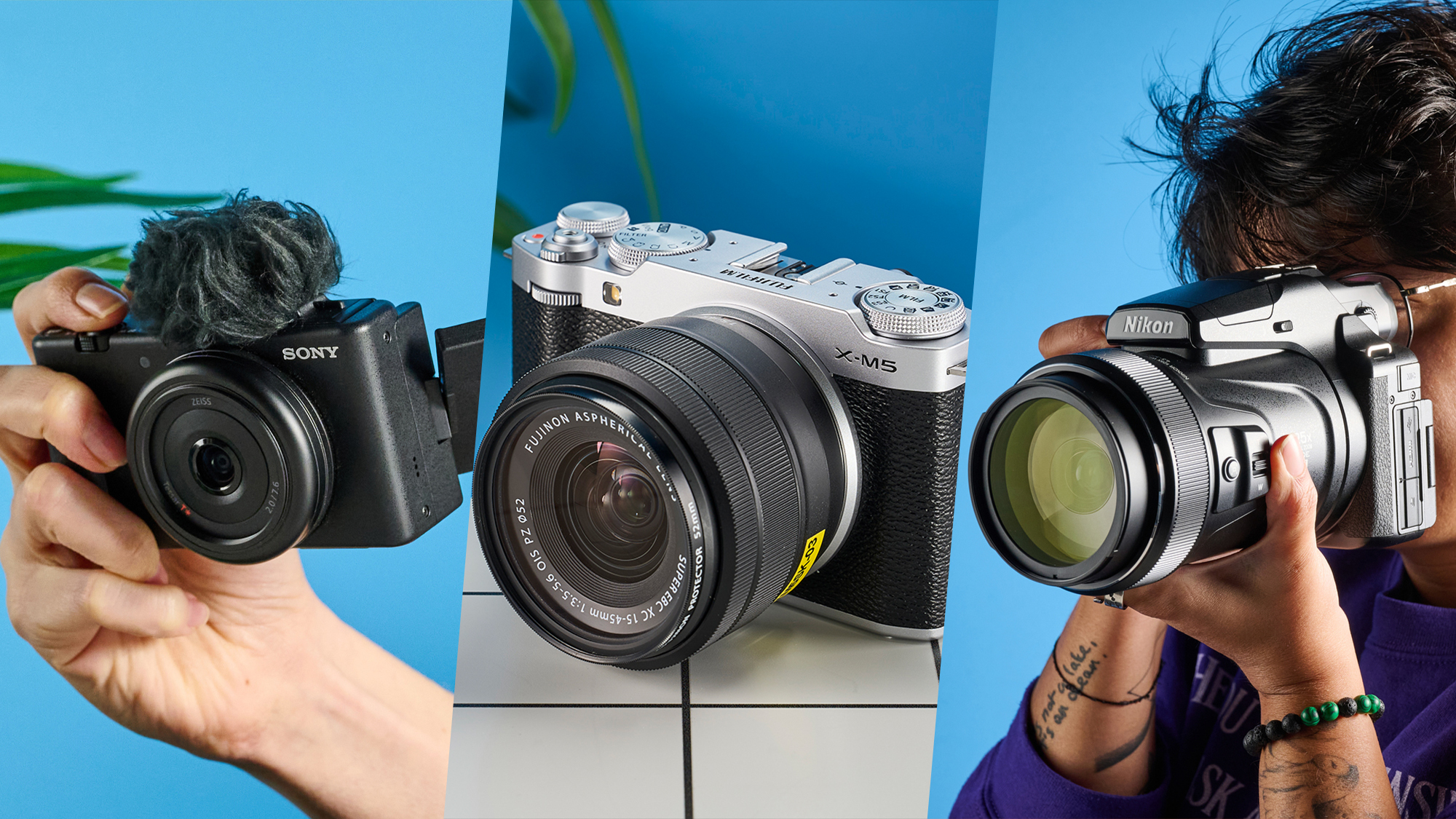Samsung Galaxy A51 vs. iPhone SE 2020: Which sub-$400 phone is best?
Here's how Samsung's new Galaxy A51 fares against the pint-sized powerhouse that is the iPhone SE
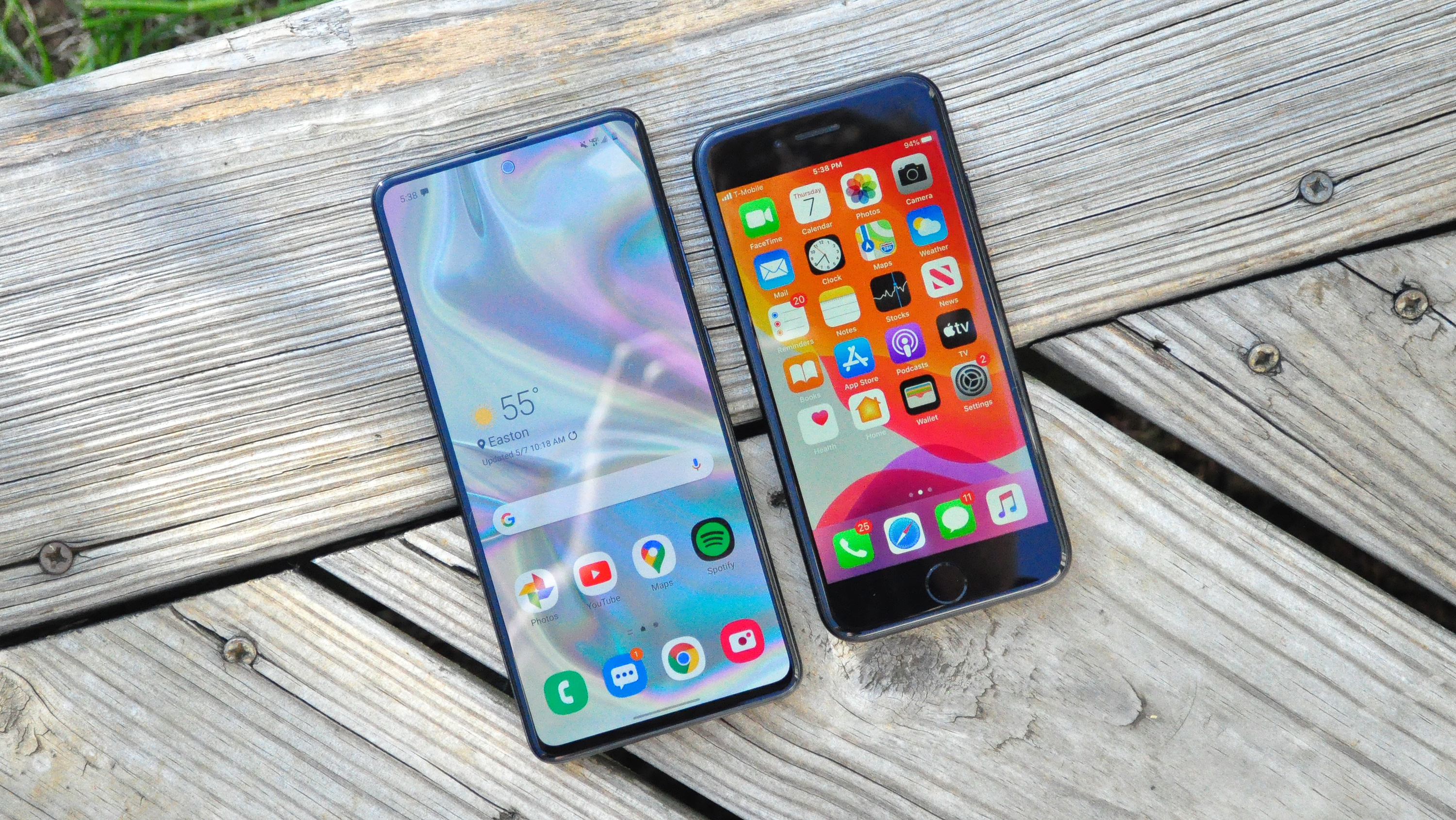
What’s the secret recipe for the best cheap phone? Both Apple and Samsung seem to believe they’ve figured it out, releasing new similarly priced midrange handsets within days of each other. However, as our Samsung Galaxy A51 vs. iPhone SE 2020 face-off highlights, these devices take very different paths to achieve that low price.
- Samsung Galaxy A51 review
- iPhone SE 2020 review
- iPhone SE 2020 vs. Pixel 4a: Can Google take back the cheap phone crown?
For the new iPhone SE 2020, it’s a story about premium performance in a pint-sized — and admittedly boring — package. The Samsung Galaxy A51, on the other hand, is all about delivering a big screen and a modern design, albeit at the expense of a fast processor or exceptional camera quality.
Here’s how these two $399 phones stack up.
Samsung Galaxy A51 vs. iPhone SE 2020: Specs
| Model | Samsung Galaxy A51 | iPhone SE |
|---|---|---|
| Starting Price | $399 | $399 |
| Screen | 6.5-inch OLED (2400x1080) | 4.7-inch LCD (1334x750) |
| CPU | Exynos 9611 | A13 Bionic |
| Storage | 128GB; expandable up to 512GB | 64GB/128GB/256GB |
| Storage | 4GB | 3GB |
| Rear Camera | 48MP wide (ƒ/2.0), 12MP ultrawide (ƒ/2.2), 5MP depth (ƒ/2.2), 5MP macro (ƒ/2.4) | 12MP (ƒ/1.8) |
| Front Camera | 32MP (ƒ/2.2) | 7MP (ƒ/2.2) |
| Colors | Prism Crush Black | Black, White, Product Red |
| Weight | 6.07 ounces | 5.2 ounces |
| Dimensions | 6.24 x 2.90 x 0.31 inches | 5.5 x 2.7 x 0.3 inches |
Samsung Galaxy A51 vs. iPhone SE 2020: Pricing and carriers
Both the Galaxy A51 and iPhone SE cost $399 and are available either unlocked or through most major and discount carriers.
There’s just one notable difference in terms of the price breakdown, and it actually works in Samsung’s favor. The Galaxy A51 comes with 128GB of storage, which is quite generous these days when you consider some flagships still only give you half that unless you spend more (looking at you, Apple and Google). The iPhone SE, however, starts at $399 for a 64GB model, and you’ll have to spend another $50 if you want 128GB. That’s not awful, though it’s something iPhone buyers should be wary of.
Winner: Samsung Galaxy A51
Samsung Galaxy A51 vs. iPhone SE 2020: Design
These phones couldn’t look more different. The Galaxy A51 is bigger than the iPhone SE in every dimension — it’s nearly an inch taller, a third of an inch wider and 0.8 ounces heavier. For that, Samsung buyers get a much larger screen, too: a 6.5-inch panel surrounded by extremely thin bezels, as opposed to the iPhone SE’s cutting-edge-for-2014 4.7-inch one.
Get instant access to breaking news, the hottest reviews, great deals and helpful tips.
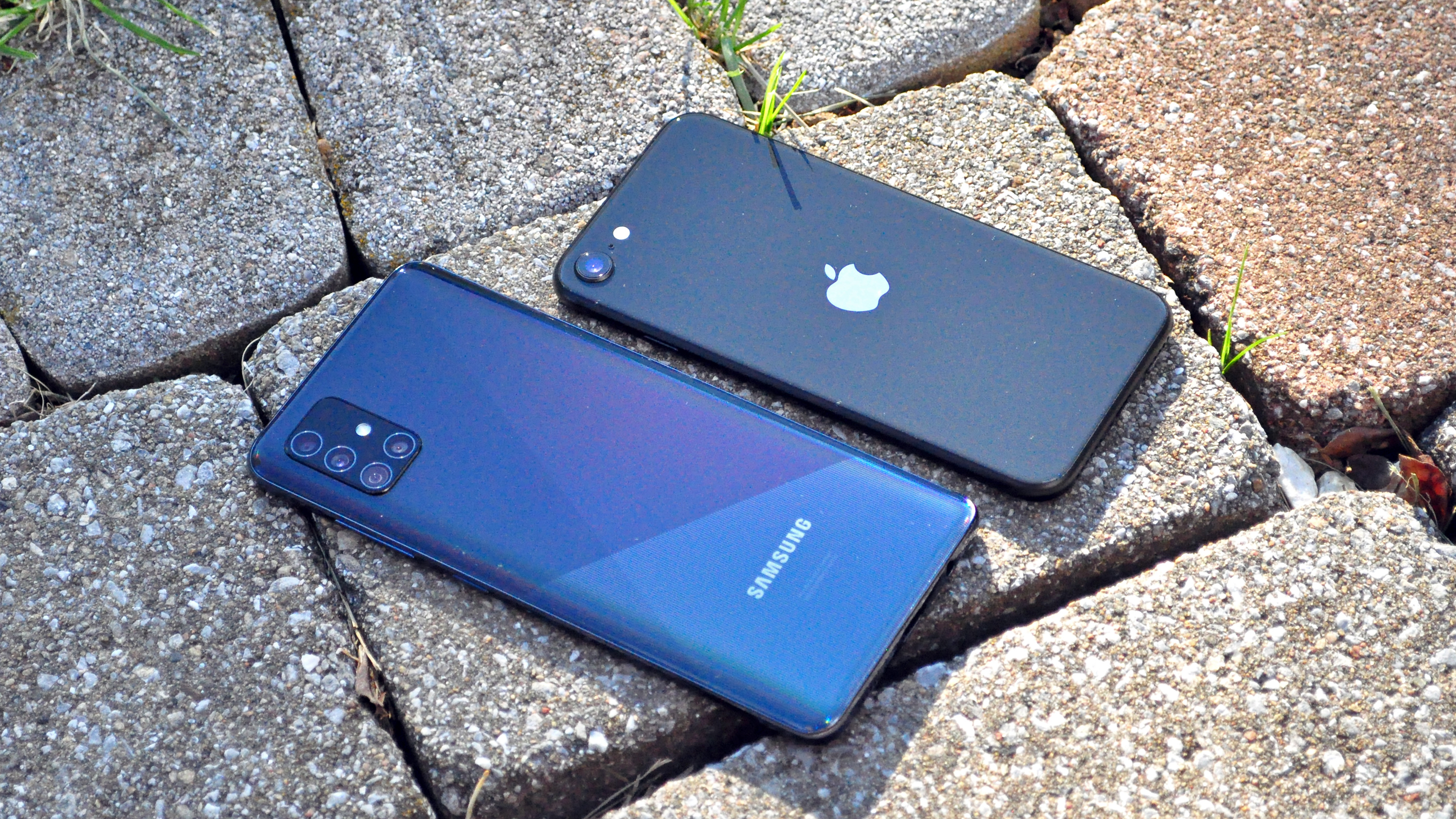
The Galaxy A51 also sports an in-display optical fingerprint sensor and a headphone jack, and you won’t find the latter 3.5-millimeter port on any modern iPhone.
However, the iPhone SE has some advantages over the Galaxy A51. Apple’s phone may be much smaller, but it’s built from more high-grade materials, like metal and glass, rather than plastic like the A51. It’s rated IP67 water resistant, and supports Qi wireless charging, too.
The Galaxy A51’s design might be more with the times, though it doesn’t feel quite as premium. Ultimately, Samsung wins out here because it’s hard to imagine not feeling just a little cramped by Apple’s 4.7-inch panel, but the gap isn’t as wide as you might assume.
Winner: Samsung Galaxy A51
Samsung Galaxy A51 vs. iPhone SE 2020: Display
One of the Galaxy A51’s premier features has to be its display. This 6.5-inch OLED screen delivers rich hues and deep blacks, and it’s sheer size makes it much more immersive than the iPhone SE’s 4.7-inch LCD panel.
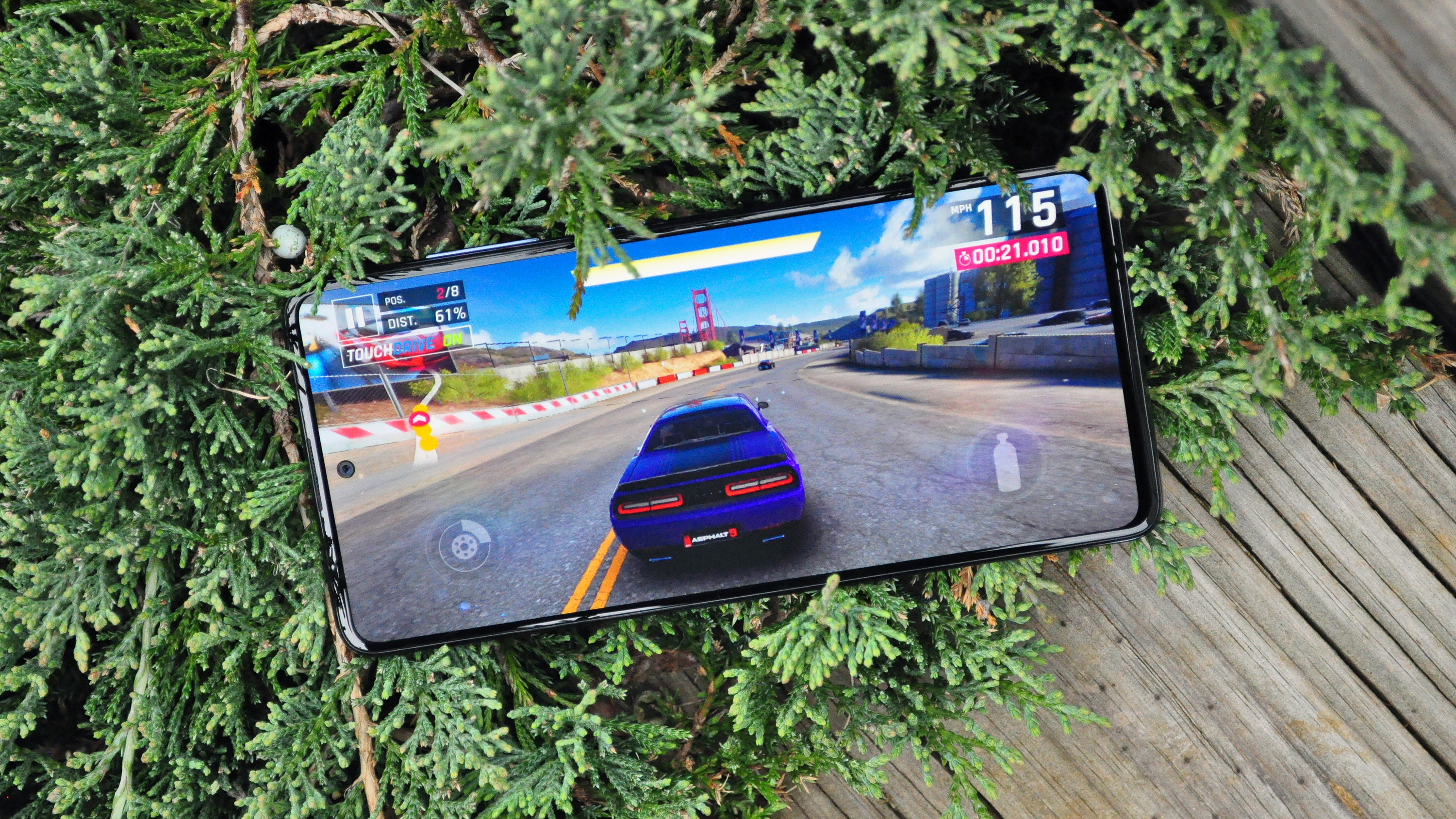
The differences in display technologies are important to note, too. The iPhone SE’s screen can certainly get brighter, with a peak of 653 nits to the Galaxy A51’s 353 nits. But colors on the iPhone display look dull compared to those on Samsung’s panel, because LCD screens lack the ability to turn pixels off in total darkness, or match the saturation you get from OLED tech. Samsung also offers two display modes — Natural and Vivid — for you to tune the appearance of content to your liking, which Apple does not.
With the A51 tuned to Vivid mode, it was able to render 212.2% of the sRGB color space, compared to the iPhone SE’s 111.2%. However, at that setting, the colors on the Samsung device are less accurate than those on the iPhone, as evidenced by the A51’s Delta-E rating of 0.30 to the iPhone SE’s 0.20 (Numbers closer to zero are better.)
Winner: Samsung Galaxy A51
Samsung Galaxy A51 vs. iPhone SE 2020: Cameras
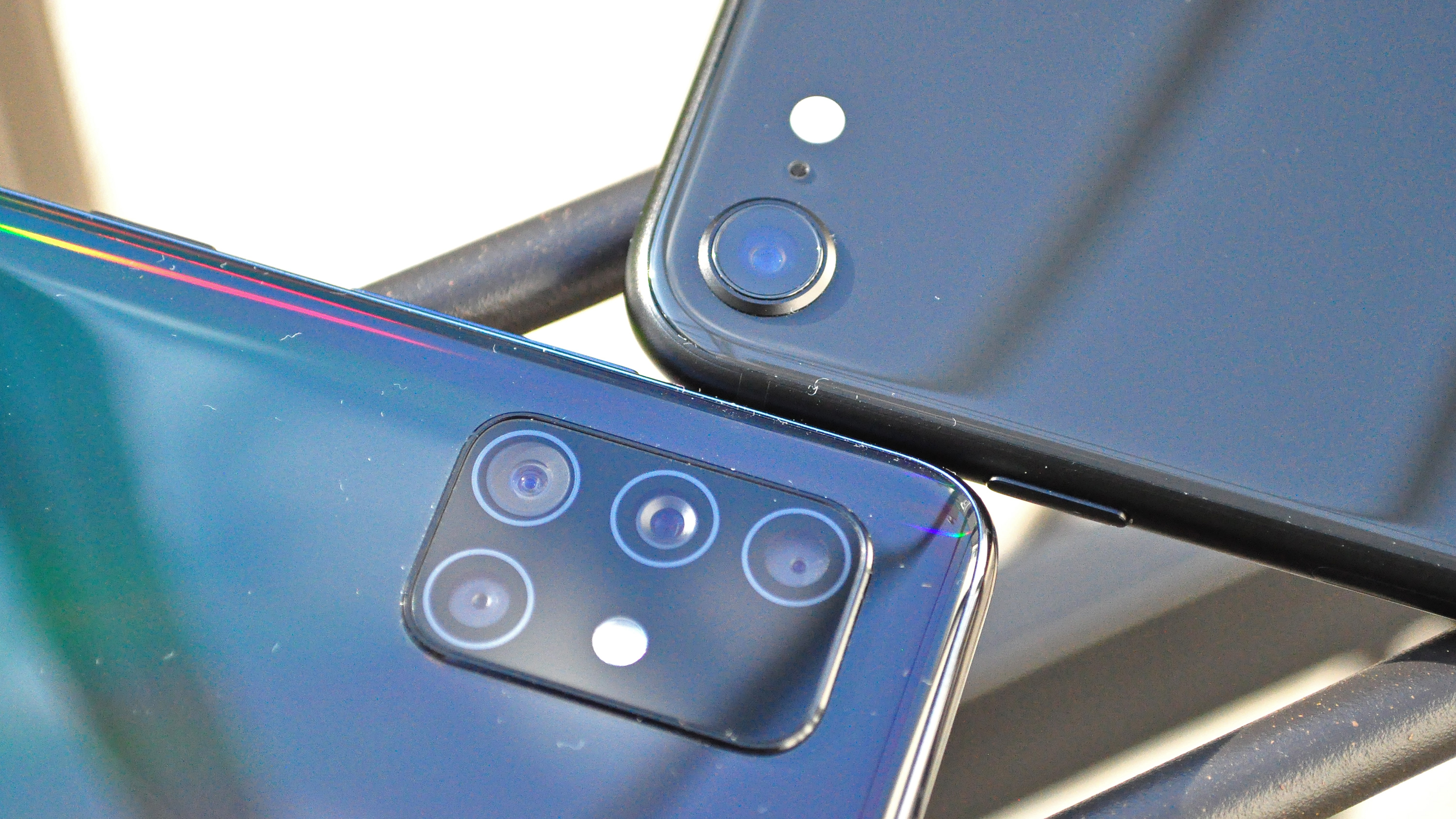
The Galaxy A51’s rear camera has four lenses to the iPhone SE’s one. Ordinarily, you’d think that puts Apple’s handset at a disadvantage when it comes to photos — but never underestimate the power of one really good camera as opposed to a handful of average ones.
The A51’s 48-megapixel, ƒ/2.0 primary shooter can capture scenes that compare well with those from the iPhone SE’s 12-megapixel, ƒ/1.8 lens, given the right conditions. Both phones deliver a striking amount of detail in their respective photos of a tiki torch, but the Galaxy’s benefits from the shallow depth of field offered by Samsung’s Live Focus mode, as well as the phone’s 5-MP depth sensor. The iPhone can only take those kinds of portraits of people, not objects.
When light is less plentiful, however, the A51’s photo quality falls off a cliff. These shots were taken at dusk, and the iPhone’s example delivers impressive detail and dramatic lighting, despite the relatively dim conditions. Samsung’s phone, on the other hand, artificially ratchets up the ISO and exposure into the stratosphere, and pumps the magenta hues up to an absurd degree. Even focusing was tricky for the A51; it repeatedly struggled to hone in on the plant, while the iPhone got itself dialed in relatively quickly.
Inside, the A51 also turned in a blown-out, drab shot of some books atop my desk. The iPhone SE nailed the colors and produced a result that was sharper as well — something most clearly visible in the text on the graphic novel to the left.
The Galaxy A51 packs a 32MP selfie lens, compared to the iPhone SE’s 8MP shooter. With four times the pixels, the A51 can certainly capture a more crisp result, though I’d rather have the iPhone’s portrait, for its slightly more natural color and better exposure of the sky against the trees in the background. Apple’s camera produced a shot that was a bit too warm, but it’s still the one I’d rather share with no editing.
The Galaxy A51 has two other lenses we haven’t yet discussed: a 12MP ultrawide and a 5MP macro. The ultrawide shooter is nice to have, and probably the A51’s only real advantage over the iPhone SE, because it enables you to shoot perspectives that plainly aren’t possible on Apple’s device. The A51’s macro lens is nice too, though we found results from that camera to be dim and lacking in color, and most buyers are less likely to get use out of it anyway. Finally, the A51 also features a Night Mode — a feature missing in action from the iPhone SE — though oftentimes in our testing it did more harm than good to low-light images shot by the A51.
Winner: iPhone SE
Samsung Galaxy A51 vs. iPhone SE 2020: Performance
You wouldn’t expect this round to be much of a contest and, well, it isn’t. The iPhone SE’s A13 Bionic chip is the very same one found in the iPhone 11 and iPhone 11 Pro, and unsurprisingly, it wipes the floor with Samsung’s midrange Exynos 9611 CPU in the Galaxy A51.
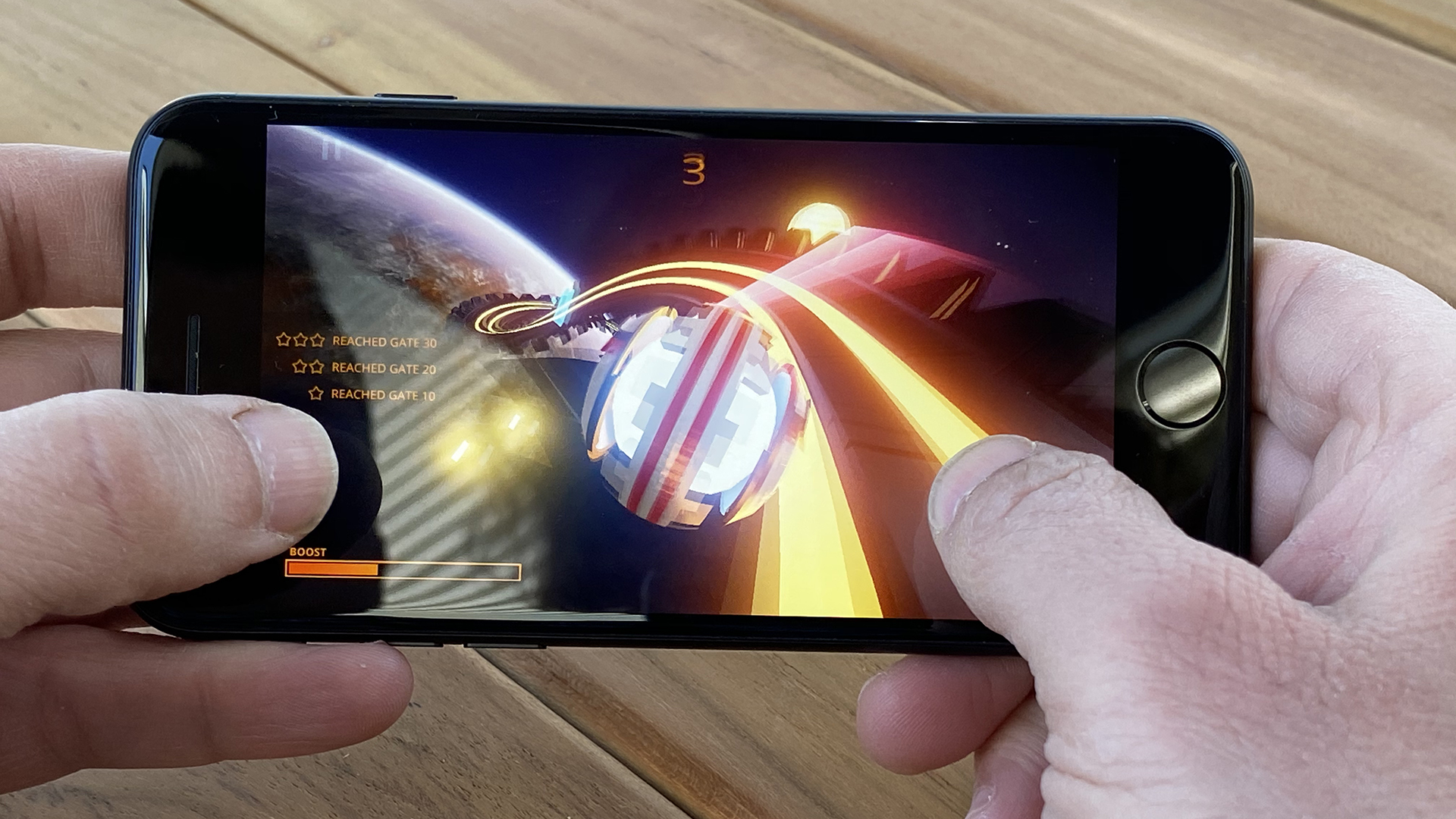
The way the numbers compare is almost laughable. Where the iPhone SE scored 3,226 points in the system-wide Geekbench 5 test, all the Galaxy A51 could muster was a measly 1,293. And in 3DMark’s Sling Shot Extreme graphics test, where the iPhone SE scored 4,001 points, the A51 proved about half as powerful, with a score of just 2,057.
You can feel the difference in performance in regular use, too. Apps on the A51 sometimes take two or three seconds to open; the camera app might hit a snag while switching modes; games don’t look as sharp or run as fast; and scrolling or swiping animations are juddery when they should be smooth. The iPhone SE suffers from none of these setbacks, and so the winner here is clear as day.
Winner: iPhone SE
Samsung Galaxy A51 vs. iPhone SE 2020: Battery life and charging
The iPhone SE’s 1,821-mAh battery is less than half the size of the 4,000-mAh one inside the Galaxy A51, and yet both phones performed almost identically in Tom’s Guide’s custom battery test.
The A51 surfed the web over LTE for 9 hours and 16 minutes until it ran out of juice — only two minutes less than the iPhone SE, which ran for 9 hours and 18 minutes. The best phone battery life in our testing begins around the 11-hour mark, so neither of those results are particularly encouraging.

However, the difference in battery size means interesting things for charging. The iPhone SE comes with just a 5-watt brick, though it supports wireless charging as well and can be fast-charged using Apple’s 18-watt USB-C adapter, if you pick that up separately for $48 (factoring in the price of the brick and cable together). The Galaxy A51 comes with a 15-watt charger out of the box. Because of the way the numbers shake out, though, both phones exhibit roughly even charge times, taking a half hour to get from completely dead to 30% with their packaged adapters.
The iPhone SE narrowly wins out here for its wireless charging perk, though it’s interesting how much efficiency Apple was able to extract from that tiny battery, likely thanks in large part to the SE’s super-small screen.
Winner: iPhone SE
Samsung Galaxy A51 vs. iPhone SE 2020: Software and special features
Samsung intends to support the Galaxy A51 with two years of Android software updates and quarterly security patches. That’s actually quite good for a budget phone, though Apple’s track record is peerless in this regard. Cupertino still supports the original iPhone SE and iPhone 6S with new releases of iOS 13, which is the type of long-term support you rarely see in this industry — especially if you’re talking about sub-$400 phones in particular.
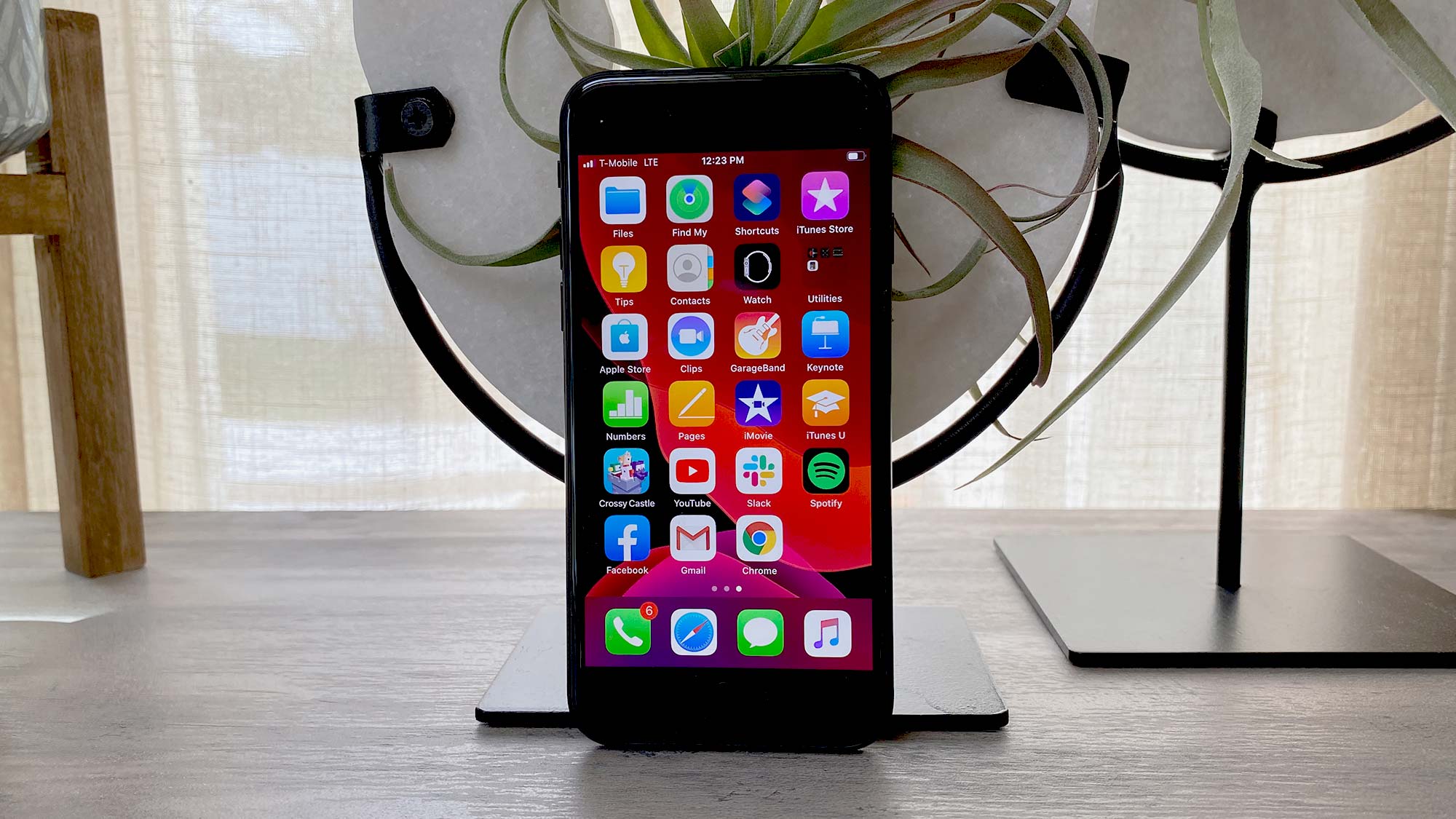
Samsung’s One UI implementation of Android 10 adds some helpful features, though we found Apple’s latest edition of iOS to be better, thanks to improvements to a number of apps, like Maps and Photos, Sign In with Apple for increased security, and a comprehensive Dark Mode that touches more of the user interface.
There’s one area of the Galaxy A51 that could especially use some tuning in future editions of the phone, and that’s Samsung’s in-screen fingerprint sensor. The scanner embedded in the A51’s display doesn’t seem to be as fast or accurate as the ultrasonic one inside the flagship Galaxy S20 series, and it’s especially sensitive to any moisture at all. If your hands are even slightly damp, your prints probably won’t register. Meanwhile, because Apple’s used an old-school capacitive sensor for Touch ID, the iPhone SE’s scanner is less temperamental.
Winner: iPhone SE
Samsung Galaxy A51 vs. iPhone SE 2020: Verdict
The Samsung Galaxy A51 may have a lot going for it, but the iPhone SE is simply a more practical purchase if you’re in the market for a $400 phone.
The iPhone’s performance is unrivaled, and its build quality is second to none — even if the design is stuck in yesterday. Its single camera captures better photos than the Galaxy A51’s four rear shooters, especially in low light. And Apple’s longstanding software support will give you the peace of mind that your iPhone will get at least some of the latest features long into its lifespan.
| Model | Samsung Galaxy A51 | iPhone SE |
|---|---|---|
| Price and availability (10) | 9 | 8 |
| Design (15) | 13 | 10 |
| Display (10) | 9 | 5 |
| Camera (20) | 13 | 18 |
| Performance (15) | 9 | 15 |
| Battery and charging (20) | 13 | 14 |
| Software (10) | 8 | 10 |
| Total (100) | 74 | 80 |
The A51 is harder to recommend over the iPhone SE, especially due to its lackluster processor. However, if the iPhone’s tiny display simply doesn’t work for you, or you really want an OLED screen to enjoy games and movies, or a headphone jack to listen to music, Samsung’s midrange Galaxy is a decent choice. For those with specific needs, it will be the right budget phone. But right now, Apple’s value is simply uncontested in this class; perhaps Google’s Pixel 4a will fare better when it arrives later this spring.
Adam Ismail is a staff writer at Jalopnik and previously worked on Tom's Guide covering smartphones, car tech and gaming. His love for all things mobile began with the original Motorola Droid; since then he’s owned a variety of Android and iOS-powered handsets, refusing to stay loyal to one platform. His work has also appeared on Digital Trends and GTPlanet. When he’s not fiddling with the latest devices, he’s at an indie pop show, recording a podcast or playing Sega Dreamcast.
